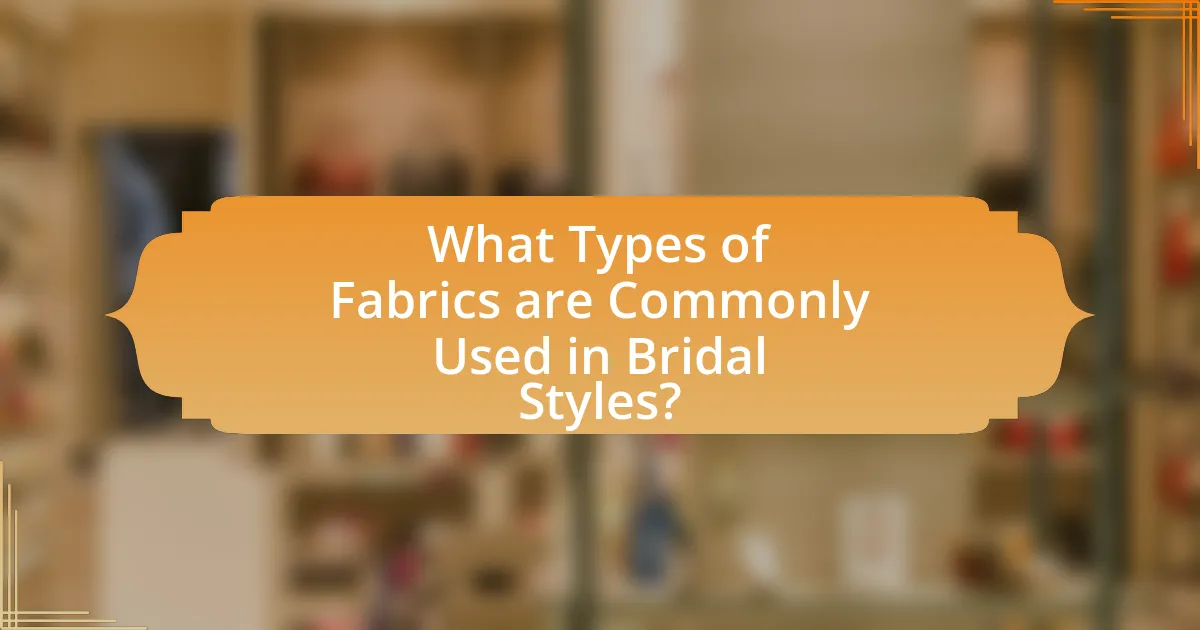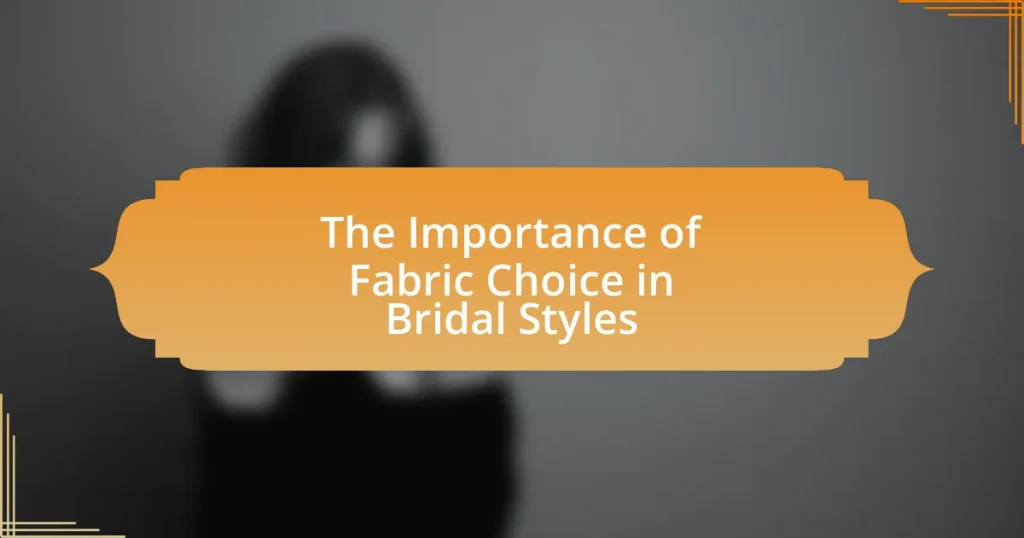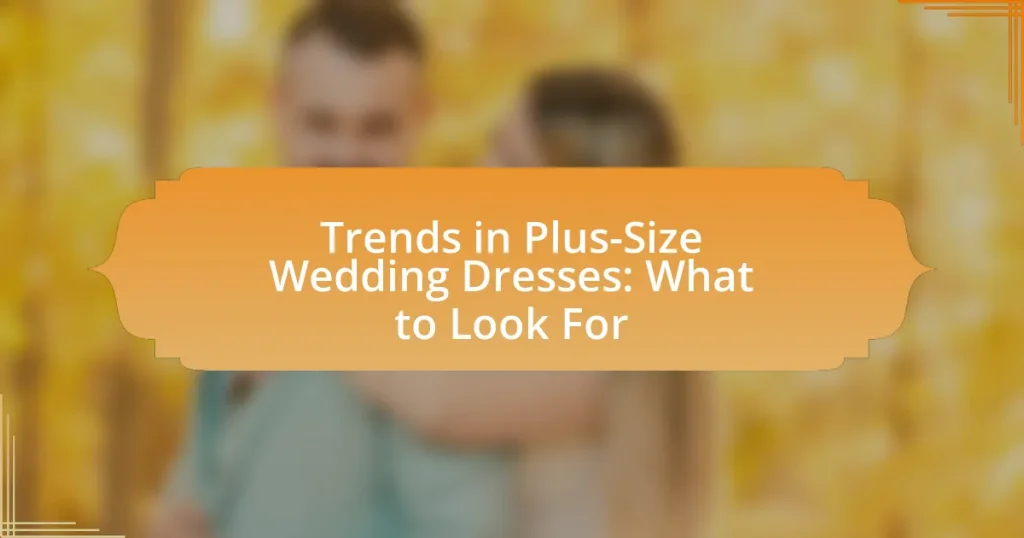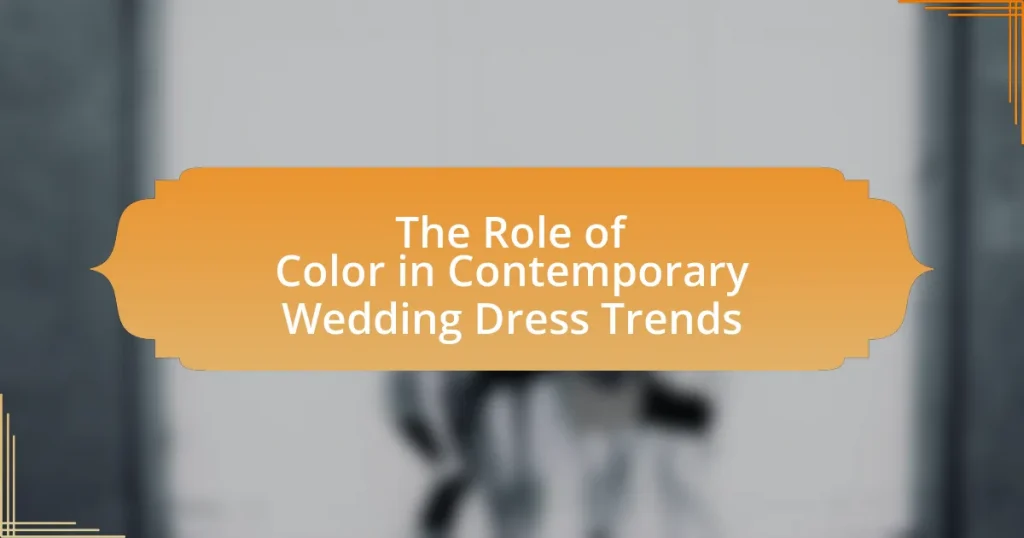The article focuses on the significance of fabric choice in bridal styles, emphasizing how different materials impact the gown’s aesthetic, comfort, and fit. It explores various factors influencing fabric selection, including design, seasonality, wedding themes, and practical considerations such as weight and breathability. The article also discusses the visual effects of fabrics, the importance of texture, and how layering can enhance bridal designs. Additionally, it provides guidance for brides on making informed fabric choices, assessing quality, and avoiding common mistakes, ensuring that their selections align with personal style and comfort for their special day.

Why is Fabric Choice Crucial in Bridal Styles?
Fabric choice is crucial in bridal styles because it directly influences the overall aesthetic, comfort, and fit of the gown. Different fabrics, such as silk, satin, lace, and tulle, offer unique textures and draping qualities that can enhance or detract from the design. For instance, silk provides a luxurious sheen and smooth drape, making it ideal for elegant silhouettes, while lace adds intricate detail and a romantic feel. Additionally, the weight and breathability of the fabric affect how the dress moves and feels throughout the day, impacting the bride’s comfort during the ceremony and reception. Therefore, selecting the right fabric is essential for achieving the desired look and ensuring the bride feels confident and comfortable on her special day.
What factors influence the selection of fabric for bridal gowns?
The selection of fabric for bridal gowns is influenced by factors such as the gown’s design, season, comfort, and budget. The design dictates the type of fabric that will best achieve the desired silhouette and aesthetic; for example, structured fabrics like satin are often used for formal styles, while lighter fabrics like chiffon are preferred for flowing designs. The season also plays a crucial role; heavier fabrics are suitable for winter weddings, while breathable materials are ideal for summer. Comfort is essential, as brides need to feel at ease throughout their special day, which can influence the choice of softer, more flexible fabrics. Lastly, budget constraints can limit fabric options, as some materials, like silk, are more expensive than others, such as polyester blends.
How does the season affect fabric choice for weddings?
Seasonality significantly influences fabric choice for weddings, as different fabrics offer varying levels of comfort and aesthetic appeal suited to specific weather conditions. For instance, lightweight fabrics like chiffon and organza are preferred for summer weddings due to their breathability and flowy nature, which help keep the bride cool. In contrast, heavier fabrics such as satin and velvet are more suitable for winter weddings, providing warmth and a luxurious feel. Additionally, seasonal colors and textures often dictate fabric selection; spring weddings may favor floral patterns and pastel colors, while autumn weddings might incorporate richer hues and textured fabrics like lace. This alignment of fabric choice with seasonal characteristics ensures both comfort and style for the bride on her special day.
What role does the wedding theme play in fabric selection?
The wedding theme significantly influences fabric selection by dictating the overall aesthetic and mood of the event. For instance, a rustic wedding theme may favor natural fabrics like linen or cotton, while a formal theme might call for luxurious materials such as silk or satin. This alignment ensures that the chosen fabrics complement the decor, color palette, and style of the wedding, creating a cohesive visual experience. Additionally, the theme can affect the weight and texture of the fabric; lighter fabrics may be preferred for outdoor summer weddings, while heavier fabrics are suitable for winter ceremonies.
How does fabric choice impact the overall bridal look?
Fabric choice significantly impacts the overall bridal look by influencing the silhouette, texture, and drape of the gown. Different fabrics, such as satin, lace, or chiffon, create distinct visual effects and can enhance or detract from the bride’s figure. For instance, satin offers a sleek and structured appearance, while lace adds a romantic and delicate touch. The drape of the fabric also affects how the gown moves, with heavier materials providing a more formal look and lighter fabrics contributing to a more ethereal feel. Studies in fashion design emphasize that the right fabric can elevate the aesthetic appeal of a bridal gown, making it essential for brides to consider how their fabric choice aligns with their desired style and overall theme of the wedding.
What are the visual effects of different fabrics on bridal gowns?
Different fabrics create distinct visual effects on bridal gowns, influencing the overall aesthetic and silhouette. For instance, silk offers a luxurious sheen and fluid drape, enhancing elegance, while lace adds texture and intricate detail, contributing to a romantic appearance. Tulle, being lightweight and airy, creates volume and a whimsical feel, often used in skirts for a fairy-tale effect. Satin, with its smooth surface, provides a polished look and can accentuate curves, making it a popular choice for form-fitting designs. Each fabric’s unique properties, such as weight, texture, and light reflection, significantly impact the gown’s visual presentation, allowing designers to evoke specific styles and emotions in bridal fashion.
How does fabric texture contribute to the gown’s aesthetic?
Fabric texture significantly enhances a gown’s aesthetic by influencing its visual appeal and tactile experience. Different textures, such as satin, lace, or tulle, create varying levels of shine, depth, and movement, which can dramatically affect the overall look of the gown. For instance, satin offers a smooth, luxurious finish that reflects light beautifully, while lace adds intricate detail and a romantic quality. The choice of texture can also impact how the gown drapes and flows, contributing to the silhouette and style. Research indicates that texture plays a crucial role in fashion perception, as it can evoke emotions and set the tone for the entire bridal ensemble.
What are the practical considerations in choosing bridal fabrics?
When choosing bridal fabrics, practical considerations include the fabric’s weight, drape, breathability, and care requirements. The weight of the fabric affects the overall silhouette and comfort; for instance, heavier fabrics like satin provide structure, while lighter fabrics like chiffon offer flow. Drape influences how the fabric falls on the body, impacting the gown’s aesthetic; fabrics with good drape, such as silk, create elegant lines. Breathability is crucial for comfort, especially in warmer climates, with natural fibers like cotton and linen being more breathable than synthetics. Lastly, care requirements vary; some fabrics may require dry cleaning, while others can be hand-washed, affecting the gown’s maintenance post-wedding. These factors collectively ensure that the chosen fabric aligns with the bride’s vision, comfort, and practicality.
How do comfort and breathability influence fabric choice?
Comfort and breathability significantly influence fabric choice by determining how the material feels against the skin and how well it allows air circulation. Fabrics that are soft and breathable, such as cotton or linen, enhance comfort, especially in bridal styles where extended wear is common. Studies indicate that breathable fabrics can reduce moisture buildup, which is crucial for maintaining comfort in warm conditions, as evidenced by research from the Journal of Textile Science, which highlights that breathable materials can improve overall wearer satisfaction. Therefore, the selection of fabrics that prioritize comfort and breathability is essential in creating bridal garments that are both aesthetically pleasing and functional.
What maintenance requirements should be considered for bridal fabrics?
Bridal fabrics require careful maintenance to preserve their appearance and integrity. Key maintenance requirements include dry cleaning for delicate fabrics like silk and lace, as water can damage their structure and finish. Additionally, storing bridal fabrics in a cool, dry place away from direct sunlight prevents fading and deterioration. Regular inspections for stains or damage are essential, as prompt treatment can prevent permanent issues. Using acid-free tissue paper for storage helps maintain shape and prevents creasing. These practices ensure that bridal fabrics remain in optimal condition for the wedding day and beyond.

What Types of Fabrics are Commonly Used in Bridal Styles?
Commonly used fabrics in bridal styles include satin, chiffon, lace, tulle, and organza. Satin is favored for its luxurious sheen and smooth texture, making it ideal for structured gowns. Chiffon is lightweight and flowy, often used for overlays and soft silhouettes. Lace adds intricate detailing and elegance, frequently seen in sleeves and bodices. Tulle, a net-like fabric, is popular for skirts and veils due to its ethereal quality. Organza, similar to tulle but crisper, is used for layers and embellishments. These fabrics are chosen for their aesthetic appeal and ability to enhance the overall design of bridal attire.
What are the characteristics of popular bridal fabrics?
Popular bridal fabrics include satin, lace, tulle, chiffon, and organza, each characterized by distinct qualities. Satin is known for its luxurious sheen and smooth texture, making it ideal for elegant gowns. Lace features intricate patterns and a delicate appearance, often used for overlays or accents. Tulle is lightweight and airy, providing volume and structure to skirts. Chiffon is soft and flowing, offering a romantic drape, while organza is crisp and sheer, adding a structured element to designs. These characteristics influence the overall aesthetic and feel of bridal attire, ensuring that each fabric choice enhances the bride’s vision for her special day.
How does silk differ from satin in bridal gown design?
Silk differs from satin in bridal gown design primarily in its texture and sheen. Silk is a natural fiber known for its luxurious feel and soft drape, which creates a flowing silhouette that enhances the gown’s elegance. In contrast, satin is a weave that can be made from silk or synthetic fibers, characterized by a glossy surface and a heavier weight, which can provide structure and a more formal appearance. The choice between silk and satin affects not only the aesthetic of the gown but also its comfort and movement, as silk tends to be lighter and more breathable, while satin offers a more structured fit.
What advantages do lace and tulle offer in bridal styles?
Lace and tulle offer significant advantages in bridal styles, primarily through their aesthetic appeal and versatility. Lace provides intricate detailing and texture, enhancing the elegance of a gown, while tulle adds volume and a light, airy quality, contributing to a romantic silhouette. The combination of these fabrics allows for diverse design options, from classic to modern looks, catering to various bridal preferences. Additionally, lace has historical significance in bridal fashion, often symbolizing tradition and sophistication, while tulle is favored for its ability to create ethereal layers, making it a popular choice for veils and skirts.
How do different fabrics affect the gown’s silhouette?
Different fabrics significantly influence a gown’s silhouette by altering its structure, drape, and overall appearance. For instance, heavier fabrics like satin and taffeta create a more structured silhouette, allowing for defined shapes and volume, which is ideal for ball gowns. In contrast, lighter fabrics such as chiffon and organza provide a softer, flowing silhouette that enhances movement and creates an ethereal look. Additionally, fabrics with stretch, like jersey, can contour to the body, resulting in a sleek, fitted silhouette. The choice of fabric directly impacts how the gown falls and interacts with the wearer’s body, ultimately shaping the visual effect and style of the gown.
What impact does fabric weight have on gown structure?
Fabric weight significantly influences gown structure by determining the drape, support, and overall silhouette of the garment. Heavier fabrics, such as satin or taffeta, provide more structure and shape, allowing for defined lines and architectural designs, which are often desired in formal bridal styles. Conversely, lighter fabrics like chiffon or organza create a softer, flowing appearance, resulting in a more ethereal look that emphasizes movement. The choice of fabric weight directly affects how the gown interacts with the body and how it holds its form, impacting the visual and tactile experience of the bridal attire.
How can layering different fabrics enhance bridal designs?
Layering different fabrics can enhance bridal designs by adding depth, texture, and visual interest. This technique allows designers to combine various materials, such as lace, tulle, and satin, creating a multidimensional look that can elevate the overall aesthetic of the gown. For instance, a satin base layer can provide structure, while a delicate lace overlay adds intricate detail, resulting in a harmonious blend that appeals to modern brides. Additionally, layering can facilitate the creation of unique silhouettes and styles, as seen in the use of contrasting fabrics to define different sections of the dress, enhancing both comfort and movement.

How Can Brides Make Informed Fabric Choices?
Brides can make informed fabric choices by understanding the characteristics and suitability of various materials for their wedding attire. Knowledge of fabric types, such as silk, satin, lace, and tulle, allows brides to select options that align with their wedding theme, comfort, and body type. For instance, silk offers a luxurious feel and drapes beautifully, making it ideal for formal weddings, while lace adds a romantic touch suitable for vintage themes. Additionally, considering factors like climate and season can influence fabric choice; lightweight fabrics are preferable for summer weddings, while heavier materials may be better for winter. Research indicates that 70% of brides prioritize comfort alongside aesthetics when choosing their wedding dress fabric, highlighting the importance of making informed decisions based on both style and practicality.
What tips should brides consider when selecting fabric for their gown?
Brides should consider the gown’s silhouette and season when selecting fabric. Fabrics like satin and silk provide structure and elegance for formal styles, while lighter materials such as chiffon and tulle are ideal for a more relaxed look, especially in warmer months. Additionally, the fabric’s weight affects comfort and movement; heavier fabrics can be restrictive, while lighter ones allow for ease of movement. Understanding the drape and texture of fabrics is crucial, as these elements influence how the gown will look and feel. For instance, lace adds a romantic touch but may require careful handling to avoid damage. Ultimately, selecting the right fabric enhances the overall aesthetic and comfort of the bridal gown.
How can brides assess fabric quality before purchasing?
Brides can assess fabric quality before purchasing by examining the fabric’s texture, weight, and durability. High-quality fabrics typically feel smooth and luxurious to the touch, while lower-quality options may feel rough or flimsy. Additionally, brides should consider the fabric’s weight; heavier fabrics often indicate better quality and durability, as they are less likely to tear or wear out quickly.
To further evaluate fabric quality, brides can perform a stretch test by gently pulling the fabric to see if it returns to its original shape, which indicates resilience. They should also check for transparency by holding the fabric up to light; quality fabrics should not be overly sheer unless intended.
Finally, brides can research the fabric type, as natural fibers like silk, cotton, and linen generally offer superior quality compared to synthetic options. According to a study published in the Journal of Textile Science, natural fibers provide better breathability and comfort, which are essential for bridal wear.
What questions should brides ask their designers about fabric options?
Brides should ask their designers about the types of fabrics available for their wedding attire. Specifically, they should inquire about the fabric’s weight, breathability, and drape, as these factors significantly affect comfort and appearance. Additionally, brides should ask about the fabric’s care requirements, durability, and how it will hold up throughout the wedding day. Understanding the fabric’s properties helps brides make informed decisions that align with their vision and the practicalities of their event.
What common mistakes should brides avoid in fabric selection?
Brides should avoid selecting fabrics solely based on trends rather than personal comfort and body type. Choosing a fabric that does not complement one’s figure can lead to dissatisfaction with the overall look. For instance, heavier fabrics like satin may not be suitable for a summer wedding, while lighter materials like chiffon can enhance comfort and movement. Additionally, brides often overlook the importance of fabric care; some materials require special cleaning, which can add stress post-wedding. Understanding the drape and weight of fabrics is crucial, as it affects how the gown will fit and flow. Therefore, brides should prioritize personal preference and practicality over fleeting fashion trends when selecting their wedding dress fabric.
How can emotional attachment to a fabric cloud judgment?
Emotional attachment to a fabric can cloud judgment by leading individuals to prioritize sentimental value over practical considerations. For instance, a bride may choose a fabric that holds personal memories, such as a family heirloom, despite its unsuitability for the wedding’s climate or style. This attachment can result in overlooking essential factors like comfort, durability, and aesthetic coherence with the overall bridal look. Research indicates that emotional connections can bias decision-making processes, causing individuals to favor choices that evoke nostalgia rather than those that align with their current needs or preferences.
What are the pitfalls of choosing fabric solely based on trends?
Choosing fabric solely based on trends can lead to several pitfalls, including poor durability, lack of comfort, and potential misalignment with the bride’s personal style. Fabrics that are trendy may not withstand the test of time, resulting in garments that wear out quickly or become outdated. For instance, synthetic materials that are popular in certain seasons may not provide the breathability or comfort needed for a wedding day, leading to discomfort for the wearer. Additionally, prioritizing trends over personal preference can result in a dress that does not reflect the bride’s individuality, ultimately diminishing her satisfaction with the garment. Historical data shows that many brides regret their fabric choices when they prioritize fleeting trends over timeless quality and personal expression.
What resources are available for brides to learn about fabric choices?
Brides can learn about fabric choices through various resources, including bridal magazines, online wedding blogs, fabric swatch books, and consultations with bridal boutiques. Bridal magazines often feature articles on fabric types, their characteristics, and how they affect the overall look of a gown. Online wedding blogs provide insights and comparisons of different fabrics, along with visual examples. Fabric swatch books allow brides to physically feel and see the materials, aiding in their decision-making process. Additionally, consultations with bridal boutiques offer personalized advice from experts who can explain the benefits and drawbacks of specific fabrics in relation to the bride’s style and wedding theme.
How can bridal expos and fabric swatches aid in decision-making?
Bridal expos and fabric swatches significantly aid in decision-making by providing firsthand experience with materials and styles. At bridal expos, brides can interact with various vendors, view a wide range of fabric options, and gain insights into current trends, which helps them visualize how different fabrics will look and feel in their wedding attire. Fabric swatches allow brides to physically assess the texture, weight, and drape of materials, enabling them to make informed choices that align with their vision and comfort. Research indicates that tactile engagement with fabrics can enhance decision-making confidence, as brides can compare swatches side by side and see how they complement their chosen designs.



